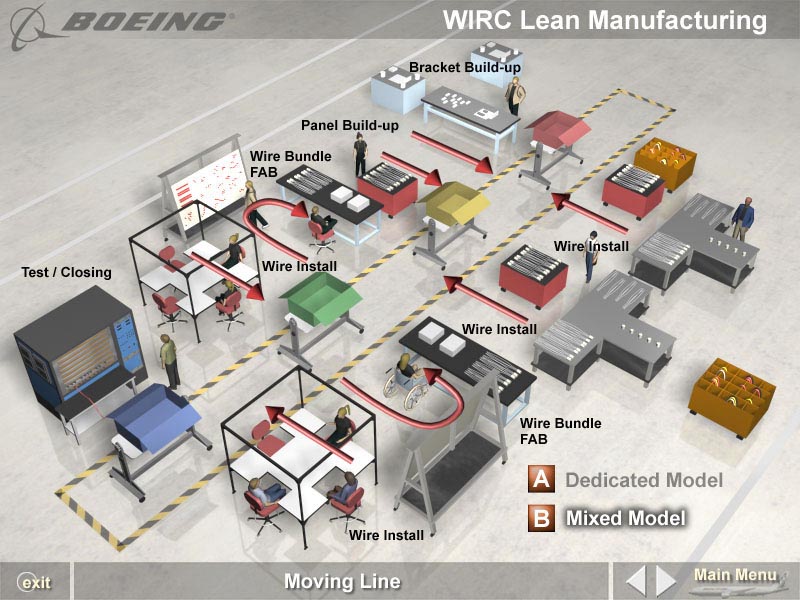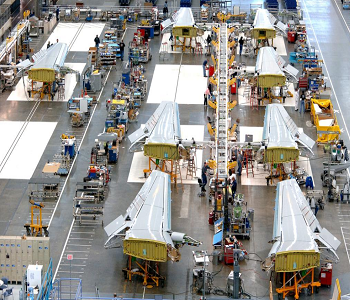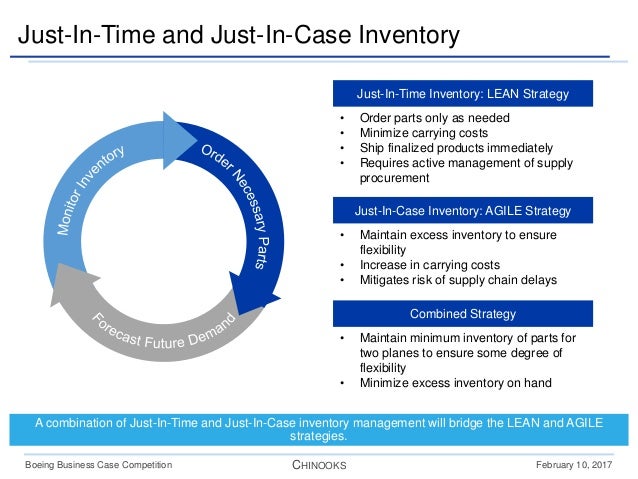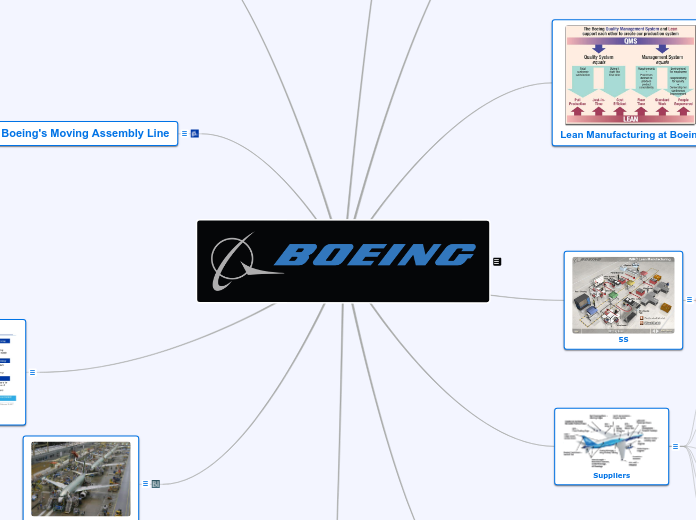
Operations & Supply Chain Management at BOEINGMario Chiesa ViscontiIE Business School - MiM - O&SC Management CourseWhy did I choose Boeing? Well, as the first aircraft manufacturer to implement a Lean strategy in its manufacturing and supply chain, I think this company is the best example to describe a successful way to implement Lean from scratch. Let's start with a brief introduction of the company.Boeing is the world's leading manufacturer of commercial aircrafts and defense, space and security systems. It designs, manufactures and sell airplanes, rockets, satellites and missiles worldwide. As the top US exporter, the company supplies airlines and government customers in 150 countries.The company is committed to be the leader in commercial aviation by providing both services and airplanes with a superior design, efficiency and value to the customer. More than 10,000 of Boeing commercial jetliners are currently flying passengers and freights worldwide more efficiently than competitors’ models available in the market (or at least we thought so).
How does Boeing build an airplane in 9 days?
The factory where Boeing produces its famous 737 airplane is the most productive in the world. At Renton plant, near Seattle, Boeing produces jets at a rate of 42 per month, taking only 9 days to complete one.The Boeing Renton Factory was originally built in 1916. In order to produce the 737 model, a new assembly line was built in 1966 and that plant is still building the Boeing 737 family. This plant, at the time it was built, was the largest building in the world by volume. New aircrafts are tested with their first flight in the adjacent Renton Municipal Airport and are then flown to Boeing field for customer preparation.

Lean Manufacturing at Boeing
In the mid 1980s Boeing began its Lean journey with the introduction of Quality Circles or Productivity Circles. This was followed by World Class Competitiveness training, 5S, and Just- in-Time workshops. Learning to use individual Lean tools like accelerated improvement workshops provided the foundation on which Boeing Commercial Airplanes created an integrated Lean strategy.The whole of The Boeing Company was embracing Lean by 1999. The strategy for becoming a Lean operation is called the 9 Tactics. A visual representation to show the entire company how all the elements of Lean fit together has evolved. Based on the Toyotal Production System, it is called the Boeing Production System.Boeing worked backwards from the the plant exit to reorient the 737 line from a 2 line slant to a single nose to tail. This change helped implement a moving line system.
Just In Time
5S
Standardised Work Procedures
Andon System
Takt Time

5S
The 5 S’s are Sort, Straighten, Shine, Standardise, Sustain.Every area in Boeing's plant was required to progress from level 1 through 5 of 5S. Massive amounts of material were surplused, recycled, or otherwise removed from areas. The Boeing Surplus Store in Puget Sound became a great shopping place for the public. Work processes became documented and standardized through 5S team meetings in office and factory areas.
Boeing's 5S Training Video

O&SCM Insights
Organize the work area:Sort (eliminate that which is not needed)Set In Order (organize remaining items)Shine (clean and inspect work area)Standardize (write standards for above)Sustain (regularly apply the standards)How does 5S help?Eliminates waste that results from a poorly organized work area (e.g. wasting time looking for a tool).

Suppliers
The Boeing objective for working with strategic suppliers is creating and enhancing long-lasting partnerships. The intent is not only to align strategies, but also share the benefits and the risks of being innovative and successful. Focusing on improving using Lean principles can lead to increased capacity, capability and market share, which in turn lead to the achievement of goals that were once thought beyond reach. To support suppliers, a Lean Engagement Model has been created that involves three different engagement approaches based on the strategic importance of suppliers and their ability to self improve
High Rank Supplier + Self Improvement
If a supplier ranks higher on the strategic scale and can self improve, Boeing will work with the supplier to align strategies and focus on improving processes between the two companies. By doing so, higher efficiencies can be reached than by either company working by itself.
Strategic Supplier + No Self Improvement
If a supplier is strategic but cannot self improve, Boeing will work with the supplier to identify and address the gaps that are preventing self improvement.
Low Rank Supplier + No Self Improvement
If a supplier does not rank high on the strategic scale and can not self improve, Boeing uses the services of external Lean consultants to help that supplier reach that self improvement plateau. The Supplier Excellence Alliance (SEA) and the Manufacturing Extension Partnerships (MEP) are two organizations that provide Lean and skill- enhancement support when needed.
Boeing's Supplier Ranking 2017
Boeing's Suppliers of the Year Awards 2017
O&SCM Insights
Boeing takes the advantages both of single sourcing and of multiple sourcing. This because although it has hundred of suppliers that let them diversify the risk and have a flexible supply chain, it treats every supplier as if they are all key.It in fact makes a yearly ranking of the suppliers, and helps the low ranked suppliers that are not able to self improve to do so. This brings also the advantages of single sourcing, having a better relationship and integration with the supplier and maintaining high quality by carefully controlling each one of them.


Boeing Today
As we all know, Boeing's 737 Max 8 Aircraft has been involved in two fatal crashes in the last 5 months. One in Indonesia and one in Ethiopia, where respectively 189 and 157 people died.This second crash in Ethiopia led vast majority of European and Asian airlines to ground their 737 jets, banning them from flying over the airspace to ensure passenger safety.What is the problem with this aircraft model is still unclear, as it is unclear if the two accidents can be linked. Some experts are hypothesising that it could be a software issue, but what is quite obvious is that the company's unbeatable Lean Manufacturing has nothing to do with it.

Andon
The Andon system, as saw in previous videos, is higly integrated in Boeing's moving assembly line. Its main use is to indicate a problem and trigger the solution through the main screen, but visual aids are scattered all over the line.Those both flashing lights that alert or highlight that actions are required, and fixed signals like pitch marks that indicate the progress relative to schedule.
Boeing's Moving Assembly Line
Boeing, like all of the aircraft manufacturers, had always been producing airplanes while parked wing to wing in a stationary position. It worked well enough, but being obsessed with growth and productivity, after several years of planning, the company gradually shifted its manufacturing plants into a moving assembly line.Boeing was the first aircraft manufacturer to implement the car industry thinking in its manufacturing plant, but the benefits were clearly evident and it was quickly imitated by competitors in the market, such as Airbus.Before planning for the line's startup could begin, employees spent significant time looking at how parts flowed to airplanes under construction and how the former production system worked. With that done, switching to a moving line required coordinating not only the assembly and tooling crews but also everyone else from suppliers to the employees who maintain the tugs that move the airplanes along the line.The transition also required employees to learn a new system that required flexibility.
a
Assembly Line First
Assembly Line After

Moving line is set at 2 inches per minute, calibrated to team task time with point of use kits.Crane moves reduced by 39%Flow times improved by 30%Inventory levels dropped by 42%Floor space reduced by 216,000 square feet
Moving Assembly line


Just In Time
As Boeing's jet production is determined by the demand pull from the customer, this way they will only produce the type of aircraft needed, when it's needed and in the optimal desired quantities.Also, supplying what is needed, when it is needed and in the amount needed according to the production plan can eliminate waste, inconsistencies and unreasonable requirements, resulting in improved productivity.
O&SCM Insights
What is Just-In-Time?Pull parts through production based on customer demand instead of pushing parts through production based on projected demand. Relies on many lean tools, such as Continuous Flow, Heijunka, Kanban, Standardised Work and Takt Time.How does Just-In-Time help?Highly effective in reducing inventory levels. Improves cash flow and reduces space requirements.

Standardised Production
What Boeing is planning to do is to use newer and more standardised manufacturer techniques for its 777x jetliner in order to achieve even more significant savings in the production process.While standardised production is common in the auto industry, it is rarer in aerospace where volumes are lower and airlines demand more customisation.However Walter Odisho, Boeing's manufacturing Vice President, said that planemakers need to make production more repeatable and predictable. Boeing has long relied on Toyota-inspired lean production methods to improve efficiency, but Odisho has been recently hired to help push car industry thinking deeper into its manufacturing plants.Boeing recently started automating the assembly of 737 wing panels, and is introducing robots on the 777 line. The aim is to automatise the areas where there are a lot of repetitive motions.They are also digging into systems with direct deliveries to their assembly lines, in order to improve the sequencing of parts. This would lead to reduction in inventories, a reduction of space needed and easing the cashflow, a recent focus for investors.

Main Takeaways
Implementing Lean and car industry thinking in aerospace manufacturing is possible and successful if well and carefully planed and designed.Suppliers are actors to take care of. If you help them to grow your company will benefit from it.A moving assembly line can be used to produce aircrafts, with very relevant benefits for the production rates.Having millions of different pieces and hundred of suppliers won't necessarily stop a company from implementing a JIT process.
